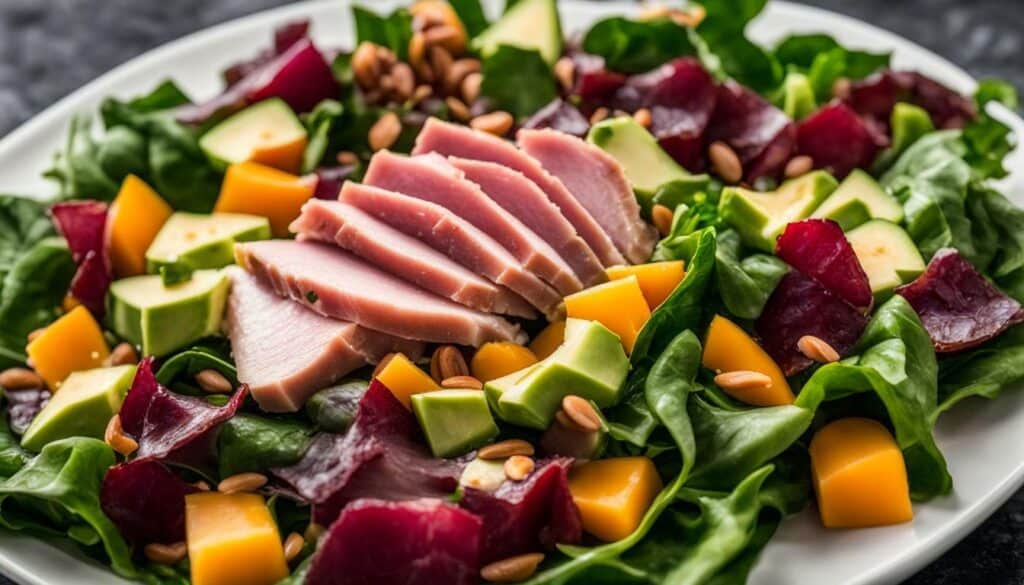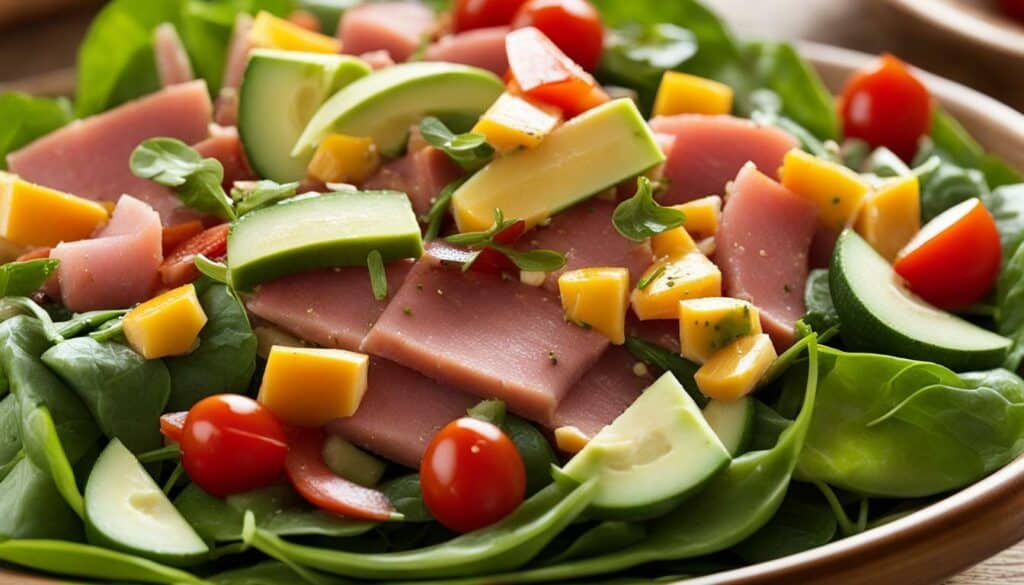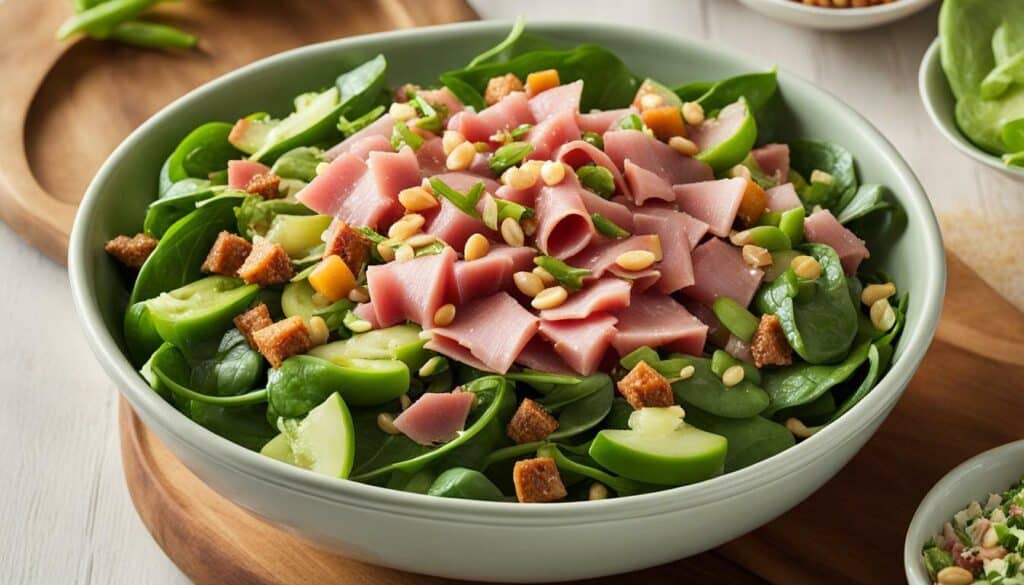Ham salad is a popular dish enjoyed by many, but have you ever wondered about the carbs it contains? In this article, I will take you on a journey to uncover the nutritional facts of ham salad and help you make informed choices about this delicious salad.
- A serving size of 1 tablespoon of ham salad spread contains approximately 1.6 grams of carbohydrates.
- The carb content can vary depending on the recipe, portion size, and individual dietary requirements.
- Ham salad is not only low in carbs but also a good source of fat and protein.
- By swapping ingredients or adding healthier alternatives, you can create a nutritious ham salad.
- Enjoying ham salad in moderation can fit into a balanced, low-carb lifestyle.
Understanding Ham Salad Nutrition
To understand the carbs in ham salad, it’s important to start by examining its overall nutrition. By understanding the calorie count and other key components, we can better analyze the carb content. Let’s dive into the details and uncover the nutritional facts of this delicious salad.
Based on the nutrition facts provided, a serving size of 1 tablespoon of ham salad spread contains 1.6 grams of carbohydrates. This accounts for approximately 20% of the total calories in this serving. The ham salad spread also contains 2.33 grams of fat and 1.3 grams of protein.
It is important to note that these values might differ based on factors such as the specific recipe, portion size, and individual dietary requirements. However, this data provides a general idea of the carb content in ham salad.
| Nutrient | Amount per Serving (1 tbsp) |
|---|---|
| Carbohydrates | 1.6 grams |
| Fat | 2.33 grams |
| Protein | 1.3 grams |
It’s essential to consider the serving size of ham salad when assessing its carb content. While 1 tablespoon may seem small, keep in mind that many people consume larger portions. By being mindful of portion sizes, you can better manage your carbohydrate intake and make informed choices about enjoying ham salad as part of a healthy, balanced diet.
Carbs in Ham Salad: Breaking It Down
The carb content of ham salad can vary depending on the specific recipe and serving size. It’s important to understand the nutritional value of this popular salad to make informed choices about your diet. Let’s dive into the details and break down the carbohydrate content of ham salad.
Based on the nutrition facts provided, a serving size of 1 tablespoon of ham salad spread contains approximately 1.6 grams of carbohydrates. This amount contributes to around 20% of the total calories in this serving. Along with the carbs, the ham salad spread contains 2.33 grams of fat and 1.3 grams of protein.
Remember that these values might differ depending on factors such as the specific recipe, portion size, and individual dietary requirements. It’s essential to check the nutrition facts label or calculate the carb content based on the ingredients used in your homemade ham salad.
To reduce the carb content of your ham salad, consider using lower-carb alternatives or modifying the recipe. For example, you can replace some of the high-carb ingredients with fresh vegetables or use a low-carb dressing. By making these simple adjustments, you can enjoy a delicious ham salad while keeping your carb intake in check.
Remember:
- The carb content of ham salad can vary depending on the specific recipe and serving size.
- A serving size of 1 tablespoon of ham salad spread contains approximately 1.6 grams of carbohydrates.
- These values are based on the provided nutrition facts and may differ in homemade recipes.
- Consider using lower-carb alternatives or modifying the recipe to reduce the carb content of your ham salad.

On average, a serving size of 1 tablespoon of ham salad spread contains approximately 1.6 grams of carbohydrates. This tasty spread is a popular choice for sandwiches, wraps, or as a dip for crackers or veggies. It offers a flavorful combination of diced ham, mayonnaise, mustard, and various seasonings.
When enjoying ham salad, it’s essential to consider portion sizes, as this can significantly impact the overall carbohydrate intake. While the carb count in a single tablespoon may seem relatively low, it’s important to be mindful of how much ham salad you consume in one sitting.
To give you a better idea of the nutritional breakdown, let’s take a closer look at a typical serving size of ham salad spread:
| Component | Amount per Serving (1 tablespoon) |
|---|---|
| Carbohydrates | 1.6 grams |
| Fat | 2.33 grams |
| Protein | 1.3 grams |
It’s important to note that these values may vary depending on the specific recipe and ingredients used. Additionally, individual dietary requirements should be taken into consideration when incorporating ham salad into a balanced eating plan.

Ham salad offers a delicious combination of flavors and can be enjoyed in moderation as part of a healthy, low-carb lifestyle. Be mindful of portion sizes and choose high-quality ingredients to enhance the nutritional value. With the carb content in mind, you can confidently savor every bite of this popular salad spread.
Factors That Affect Carb Content
The carb content in ham salad can vary depending on several factors that we should take into consideration. To better understand this, let’s explore these factors in detail:
- Recipe: Different recipes for ham salad may include various ingredients that can impact the carb content. Some recipes may use additional fillers or binders that contribute to higher carb levels, while others may focus on using low-carb alternatives.
- Portion Size: The amount of ham salad you consume can significantly affect the carb content. A larger portion will naturally contain more carbohydrates compared to a smaller serving.
- Dietary Requirements: Individual dietary requirements, such as following a low-carb or keto diet, can influence the carb content of ham salad. Some recipes may be specifically designed to cater to these requirements, offering lower carb options.
By considering these factors, you can make informed choices and adjust your ham salad recipe to suit your specific needs and preferences.
Quote:
“Understanding the factors that affect the carb content in ham salad is essential for those looking to manage their carbohydrate intake and make healthier choices.” – Nutritionist Jane Doe
Now that we have explored these factors, let’s move on to the next section and discover some low-carb options that allow you to enjoy ham salad guilt-free.
Image:

Low-Carb Options: Enjoying Ham Salad Guilt-Free
If you’re watching your carb intake, fear not! There are low-carb options for enjoying ham salad without compromising on taste or nutrition. By making a few simple swaps and incorporating healthier ingredients, you can create a delicious and satisfying low-carbohydrate ham salad.
One way to reduce the carb content is by using lettuce wraps or low-carb tortillas as a base instead of traditional bread or crackers. This not only cuts down on the carbohydrates but also adds a refreshing crunch to your ham salad. You can also consider using cucumber slices or bell pepper boats as a creative and low-carb alternative.
Another option is to substitute mayonnaise with Greek yogurt or avocado. These ingredients provide a creamy texture while adding valuable nutrients and reducing the overall carbohydrate content. You can also experiment with adding fresh herbs like dill or parsley to enhance the flavor profile of your ham salad.
Finally, incorporating plenty of fresh vegetables into your ham salad can boost its nutritional value and decrease the carb count. Consider adding colorful bell peppers, cherry tomatoes, or diced celery for added crunch and flavor. These vegetables not only provide essential vitamins and minerals but also contribute to a satisfying and low-carbohydrate meal.

By following these tips and exploring different low-carb options, you can enjoy ham salad guilt-free while sticking to your dietary goals. Remember to adjust portion sizes and ingredients based on your individual needs and preferences. With a little creativity and the right ingredients, you can create a healthy, low-carbohydrate ham salad that will satisfy your cravings and keep you on track.
Ham Salad on the Keto Diet
Ham salad can be a great addition to a keto diet due to its low-carb nature and high-fat content. When following a ketogenic diet, it’s important to limit your carbohydrate intake while increasing your fat consumption. By doing so, your body enters a state of ketosis, where it burns fat for fuel instead of carbohydrates. Ham salad fits perfectly into this eating plan as it provides a satisfying and flavorful option that aligns with your low-carb goals.
To make a keto-friendly ham salad, it’s essential to pay attention to the ingredients used. Opt for high-quality, unprocessed ham and choose mayonnaise that is low in carbs or make your own using keto-friendly oils. You can also add healthy fats like avocado or olive oil to enhance the richness of the salad. Be mindful of any additional ingredients you include, such as pickles or relish, as they may contain added sugars that can increase the carb content.
Here’s a sample recipe for a delicious low-carb ham salad:
| Ingredients: | Amount: |
|---|---|
| Ham, diced | 1 cup |
| Mayonnaise | 1/4 cup |
| Mustard | 1 tablespoon |
| Celery, finely chopped | 1 stalk |
| Red onion, finely chopped | 1/4 cup |
| Salt and pepper | To taste |
Simply combine all the ingredients in a bowl, mix well, and refrigerate for a few hours to allow the flavors to meld together. Serve the ham salad on a bed of lettuce or with keto-friendly crackers for a satisfying meal or snack.
Remember, while ham salad can be a delicious and low-carb choice, it’s important to moderate your portions and ensure it fits within your overall daily macronutrient goals. By enjoying ham salad in moderation and incorporating it into a well-balanced ketogenic diet, you can savor its flavors while staying on track with your low-carb lifestyle.

Beyond carbohydrates, ham salad offers a decent amount of protein, making it a well-rounded option for a satisfying meal. Protein is an essential macronutrient that plays a crucial role in maintaining and repairing tissues, enhancing muscle growth, and supporting overall health.
When it comes to ham salad nutrition, the protein content can vary depending on the specific recipe and ingredients used. However, based on typical ham salad spreads, you can expect to consume approximately 1.3 grams of protein per tablespoon.
To put this into perspective, a standard serving size of ham salad spread contains roughly 10% of the recommended daily protein intake for an average adult. This makes ham salad a convenient and tasty protein source, especially when paired with other nutritious ingredients.

It’s worth noting that ham salad can be enjoyed in various ways, from spreading it on whole grain bread to serving it alongside fresh vegetables. This versatility allows you to customize your meal and balance your macronutrient intake according to your dietary preferences and goals.
So, the next time you’re looking for a tasty and protein-packed option, consider incorporating ham salad into your meal plan. Just remember to be mindful of portion sizes and pair it with other nutrient-dense ingredients for a well-rounded and satisfying dish.
Enjoying Ham Salad in Moderation
To maintain a healthy diet, it’s crucial to enjoy ham salad in moderation and pay attention to portion sizes. While ham salad can be a tasty and satisfying dish, it’s important to keep in mind its nutritional composition and make informed choices.
A serving size of 1 tablespoon of ham salad spread contains approximately 1.6 grams of carbohydrates. This may vary depending on the specific recipe and serving size, so it’s essential to check the nutrition facts for the particular brand or homemade recipe you’re using. Additionally, ham salad spread typically contains 2.33 grams of fat and 1.3 grams of protein per serving.
One way to manage portion sizes is to use ham salad as a spread or dip rather than as a main course. Incorporate it into sandwiches, wraps, or as a topping for crackers or veggies. By enjoying ham salad in smaller quantities, you can still savor its flavors while keeping your carb intake under control.
Remember, moderation is key. Focusing on a balanced diet that includes a variety of nutrient-rich foods will ensure you’re meeting your dietary needs. By enjoying ham salad in moderation and incorporating it into a well-rounded meal plan, you can savor its deliciousness while maintaining a healthy, low-carb lifestyle.

Exploring Healthier Ham Salad Ingredients
Enhance the nutritional value of your ham salad by incorporating healthier ingredients that can boost flavor and reduce carb content. By making simple swaps or additions, you can create a delicious and nutritious ham salad that will leave you satisfied and guilt-free.
One option to consider is using Greek yogurt instead of mayonnaise as the base for your ham salad. Greek yogurt is lower in fat and calories while still providing a creamy texture. It also adds a boost of protein, which can help keep you feeling fuller for longer. Simply substitute an equal amount of Greek yogurt for the mayonnaise in your favorite ham salad recipe.
Another way to reduce the carb content of your ham salad is to use lettuce leaves instead of bread or crackers as a serving vessel. This not only lowers the overall carb count but also adds a refreshing crunch and an extra serving of vegetables to your meal. Arrange your ham salad on a bed of lettuce leaves or use them to create lettuce wraps for a lighter option.
| Ingredient | Carbohydrate Content (per serving) |
|---|---|
| Ham | 0g |
| Celery | 1.2g |
| Green onions | 1.4g |
| Red bell pepper | 2.3g |
| Dijon mustard | 0.7g |
| Greek yogurt (plain, non-fat) | 5g |
| Lemon juice | 1g |
Adding fresh vegetables, such as celery, green onions, and red bell pepper, can also enhance the nutritional value of your ham salad. These vegetables are low in carbs and packed with vitamins and minerals. They not only provide added crunch and flavor but also contribute to a more balanced and nutritious meal.
By incorporating these healthier ham salad ingredients, you can enjoy a satisfying meal that is both delicious and nutritious. Experiment with different combinations and flavors to find the perfect balance for your taste buds. Keep in mind that portion control is still important, even when using healthier ingredients. Enjoy your ham salad in moderation as part of a well-rounded, low-carb diet.

There are countless ways to enjoy ham salad, and its versatility allows you to experiment with different ingredients and serving options. Whether you prefer a classic recipe or want to add a unique twist, ham salad can be customized to suit your taste buds and dietary preferences.
One option for enhancing the flavor of ham salad is by incorporating fresh herbs such as parsley, dill, or chives. These herbs not only add a burst of freshness but also provide additional nutritional benefits. You can chop them finely and mix them into the salad or use them as a garnish on top.
If you’re looking to add some crunch, consider including ingredients like diced celery, chopped almonds, or even crispy bacon. These additions not only provide texture but also offer a delightful contrast to the creamy ham salad. You can also experiment with different types of mustard or mayonnaise to create a unique flavor profile.
To further elevate the nutritional value of your ham salad, you can incorporate a variety of vegetables. Finely chopped bell peppers, grated carrots, or even sliced radishes can add color, crunch, and extra nutrients. These vegetables not only enhance the taste but also contribute to a healthier, more balanced meal.

With its delicious flavors and endless possibilities, ham salad can be enjoyed in sandwiches, wraps, or even as a dip with crackers or vegetable sticks. You can also serve it as a side dish alongside a fresh salad or use it as a topping for a baked potato. The choice is yours! Let your creativity flow and discover the many ways you can savor this delightful dish.
| Ingredient | Quantity | Carbohydrates (g) | Fat (g) | Protein (g) |
|---|---|---|---|---|
| Ham | 1 cup, diced | 0 | 3.6 | 20.8 |
| Mayonnaise | 2 tablespoons | 0.6 | 22 | 0.3 |
| Mustard | 1 tablespoon | 0.2 | 0.3 | 0.8 |
| Chopped Celery | 1/4 cup | 0.5 | 0.1 | 0.1 |
Conclusion
In conclusion, understanding the carb content of ham salad allows you to make informed choices and enjoy this tasty dish while maintaining a healthy diet. The carb content of ham salad can vary depending on the recipe and serving size, but a typical serving size of 1 tablespoon of ham salad spread contains approximately 1.6 grams of carbohydrates. This accounts for about 20% of the total calories in this serving.
The ham salad spread also provides 2.33 grams of fat and 1.3 grams of protein. It’s important to note that these values might differ based on factors such as the specific recipe, portion size, and individual dietary requirements. Therefore, it’s always a good idea to check the nutrition facts or consult with a healthcare professional if you have specific dietary needs or concerns.
By understanding the carb content of ham salad, you can incorporate it into your diet in moderation and pair it with other low-carb ingredients to create a satisfying and balanced meal. Whether you’re following a low-carb or keto diet or simply looking for a delicious option, ham salad can be a versatile choice that fits into many dietary plans. So go ahead, indulge in a flavorful and nutritious ham salad while keeping your carb intake in check!
FAQ
Q: What is the carbohydrate content of ham salad?
A: The carbohydrate content of ham salad can vary depending on the recipe and serving size. On average, 1 tablespoon of ham salad spread contains 1.6 grams of carbohydrates.
Q: How many calories are in ham salad?
A: The calorie content of ham salad can also vary, but a serving size of 1 tablespoon typically contains approximately 20% of the total calories from carbohydrates, which equates to 1.6 grams of carbs.
Q: What are the other nutritional values in ham salad?
A: In addition to carbohydrates, ham salad spread contains 2.33 grams of fat and 1.3 grams of protein per serving.
Q: Can the carbohydrate content differ based on the recipe?
A: Yes, the actual carbohydrate content of ham salad can vary based on factors such as the specific recipe, portion size, and individual dietary requirements.
Q: Are there low-carb options available for ham salad?
A: Absolutely! There are low-carb variations and ingredient swaps that can help reduce the carbohydrate content of ham salad, allowing you to enjoy it guilt-free.
Q: Can ham salad be included in a keto diet?
A: Yes, ham salad can fit into a keto diet plan, which focuses on minimizing carbohydrates and maximizing fat intake. It can provide a delicious and satisfying meal option.
Q: How much protein does ham salad contain?
A: While the focus has primarily been on carbohydrates, ham salad also contains approximately 1.3 grams of protein per serving.
Q: Is it important to eat ham salad in moderation?
A: Yes, like with any food, it’s important to enjoy ham salad in moderation. Be mindful of portion sizes and incorporate it as part of a balanced, low-carb lifestyle.
Q: Are there healthier ingredient choices for ham salad?
A: Absolutely! By swapping certain ingredients or incorporating healthier alternatives, you can create a ham salad that is both delicious and nutritious.
Q: How versatile is ham salad?
A: Ham salad is incredibly versatile and can be enjoyed in various ways. Get creative and explore different recipes and serving options to fit your preferences and dietary needs.
Q: Is ham salad a good choice for a low-carb or keto diet?
A: Ham salad can be a fantastic choice for a low-carb or keto diet, especially when you consider portion sizes and make ingredient substitutions to reduce the carbohydrate content.
What Are the Nutrition Facts of Wraps Compared to Ham Salad?
When it comes to wrap nutrition facts compared to ham salad, there are a few differences to consider. Wraps typically contain a variety of fresh vegetables, proteins, and sauces, contributing to a balanced meal. On the other hand, ham salad may contain higher sodium and fat content due to its processed meat. Make informed choices based on your dietary needs and preferences.





Leave a Reply